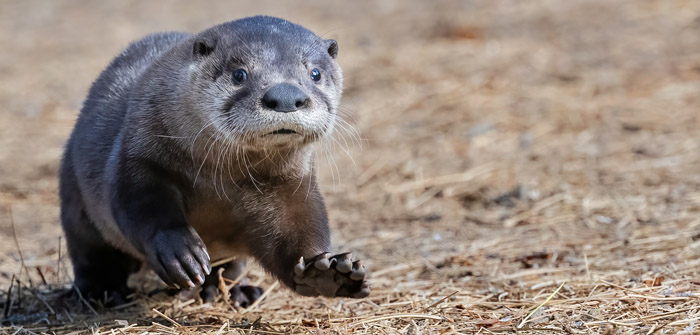(Baby otter — June 2022 | Photo by John Williams)
High Desert Museum visitors will have their first official opportunity to see the new, baby North American river otter on Wednesday, September 21 when he joins two other otters full-time in the Autzen Otter Exhibit.
The Museum will celebrate the addition of the male pup, now approximately 5 1/2 months old, at 2:30pm. Visitors will be able to view the pup, who is yet to be named, as well as the other two male otters in the Museum’s care, Brook and Pitch. Naturalists will be at an Otter Fodder Interpretation Station to share interesting scientific facts about this mammal, as well as pelts, skulls and other interactive items to engage visitors.
“North American river otters are so playful and engaging, and they have so much to teach us about riparian ecosystems,” said Museum Executive Director Dana Whitelaw, Ph.D. “We’re excited for the public to share the excitement of welcoming this new addition to the Museum.”
Wednesday, September 21, is also Senior Day at the Museum, with those age 65 and older receiving free admission. Senior Day is made possible by Mid Oregon Credit Union.
Visitors will still be able to access otter activities beyond this Wednesday. Naturalists will continue sharing at the Otter Fodder Interpretation Station, which will be located after Wednesday inside the Autzen Otter Exhibit, regularly throughout October from 10am to 1pm. And daily Otter Encounter naturalist talks will take place at the Autzen Otter Exhibit at 1pm through November.
Wednesday is not the baby’s first time in the Autzen Otter Exhibit. He was introduced in doses over the course of months as part of helping him become confident in the habitat and acquainting the three otters with each other. This took place with wildlife staff supervision.
“We supervised early interactions while the baby otter was small to make sure everyone stayed safe,” Museum Curator of Wildlife Jon Nelson said. “He’s not quite as big as the older otters yet, but they are all getting along well and enjoying playing, eating and napping together. They do quite a bit of roughhousing, and the baby holds his own with Pitch and Brook.”
Before exposure to the exhibit habitat, the pup also needed time in the water to become a proficient swimmer. Wildlife curators helped the otter splash in the Museum’s stream and in a human child’s play pool before bringing him into the water of the exhibit.
The otter came into the care of the Museum in May after he was found away from water on a golf course near Sunriver. Then believed to be about eight weeks old, he was emaciated and severely dehydrated, and after multiple wildlife professionals attempted to locate his mother over nearly a week, the state determined he should remain at the Museum.
“Without his parents he wouldn’t have survived in the wild,” Nelson said. “This was a unique situation where this otter pup does appear to have been legitimately orphaned.”
The pup, which weighed 2.4 pounds on arrival, presently weighs about 15 pounds. In the wild, otters become independent at about 12 months old.
“Caring for a young otter is intense work, and our wildlife team has done an incredible job juggling bottle feedings around the clock early on and supervising the otter through this time,” Whitelaw said.
This is not the first young otter to come into the Museum’s care. Pitch was found along the Metolius River and was brought to the Museum in 2017, and wildlife staff raised him from about seven weeks old.
Brook, the other male otter, is approximately ten years old. In March, a third river otter, Rogue, 12, was humanely euthanized after his health deteriorated rapidly. Otters live about eight to nine years in the wild, and often longer in human care.
The Museum cares for more than 130 animals, from otters to raptors. All the animals are nonreleasable, primarily due to injuries or because they are habituated — meaning they became too familiar with humans and possibly never learned how to hunt or avoid predators. At the Museum, they serve as ambassadors who educate visitors about the conservation of High Desert species and landscapes.
The opportunity to name the new otter was auctioned off in August at the High Desert Rendezvous, the Museum’s largest fundraising event of the year. The winning bidder has yet to determine the name.





